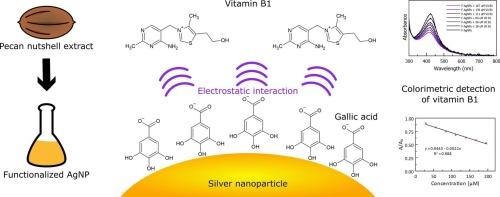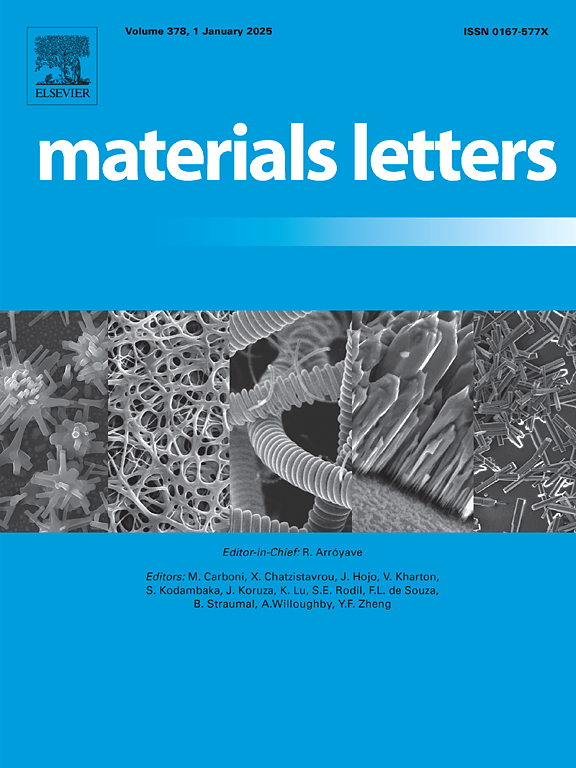Surface functionalization of silver nanoparticles with pecan nutshell extract for the colorimetric detection of vitamin B1
IF 2.7
4区 材料科学
Q3 MATERIALS SCIENCE, MULTIDISCIPLINARY
引用次数: 0
Abstract
Vitamin B1 plays an important role in many biological processes and an imbalance of this biomolecule may negatively alter biogeochemical cycles and harm aquatic life, making its monitoring crucial for public health and environmental preservation. Recent efforts have been focused on developing simple, cost-effective sensors to monitor water quality. Colorimetric sensors, particularly those utilizing noble metal nanoparticles, are a promising solution. In this work, the synthesis of silver nanoparticles via chemical reduction is reported, followed by their surface functionalization with molecules extracted from the pecan nutshell. Silver nanoparticles with an average particle size of 8.2 nm were synthesized via chemical reduction by using sodium borohydride as a reducing agent and then, functionalized with biomolecules extracted from pecan nutshell. The functionalized and non-functionalized Ag nanoparticles were tested for the colorimetric detection of vitamin B1. A LOD of 18.5 µM and a R2 value of 0.988 were found for the functionalized Ag nanoparticles, presenting a notable improvement compared to the detection using non-functionalized nanoparticles. Hence, the functionalization of silver nanoparticles with biomolecules significantly enhances the colorimetric detection of vitamin B1. Moreover, this methodology can be extended for the detection of other analytes of interest.

山核桃果提取物纳米银表面功能化对维生素B1比色检测的影响
维生素B1在许多生物过程中发挥着重要作用,这种生物分子的失衡可能会对生物地球化学循环产生负面影响并危害水生生物,因此对其进行监测对公众健康和环境保护至关重要。最近的努力集中在开发简单、成本效益高的传感器来监测水质。比色传感器,特别是那些利用贵金属纳米粒子的传感器,是一个很有前途的解决方案。在这项工作中,报告了通过化学还原合成纳米银,然后用从山核桃果壳中提取的分子进行表面功能化。以硼氢化钠为还原剂,采用化学还原法制备了平均粒径为8.2 nm的银纳米粒子,并用山核桃果中提取的生物分子进行功能化。研究了功能化和非功能化银纳米粒子对维生素B1的比色检测。与非功能化纳米粒子相比,功能化银纳米粒子的LOD为18.5µM, R2为0.988,具有显著的提高。因此,纳米银与生物分子的功能化显著增强了维生素B1的比色检测。此外,这种方法可以扩展到其他感兴趣的分析物的检测。
本文章由计算机程序翻译,如有差异,请以英文原文为准。
求助全文
约1分钟内获得全文
求助全文
来源期刊

Materials Letters
工程技术-材料科学:综合
CiteScore
5.60
自引率
3.30%
发文量
1948
审稿时长
50 days
期刊介绍:
Materials Letters has an open access mirror journal Materials Letters: X, sharing the same aims and scope, editorial team, submission system and rigorous peer review.
Materials Letters is dedicated to publishing novel, cutting edge reports of broad interest to the materials community. The journal provides a forum for materials scientists and engineers, physicists, and chemists to rapidly communicate on the most important topics in the field of materials.
Contributions include, but are not limited to, a variety of topics such as:
• Materials - Metals and alloys, amorphous solids, ceramics, composites, polymers, semiconductors
• Applications - Structural, opto-electronic, magnetic, medical, MEMS, sensors, smart
• Characterization - Analytical, microscopy, scanning probes, nanoscopic, optical, electrical, magnetic, acoustic, spectroscopic, diffraction
• Novel Materials - Micro and nanostructures (nanowires, nanotubes, nanoparticles), nanocomposites, thin films, superlattices, quantum dots.
• Processing - Crystal growth, thin film processing, sol-gel processing, mechanical processing, assembly, nanocrystalline processing.
• Properties - Mechanical, magnetic, optical, electrical, ferroelectric, thermal, interfacial, transport, thermodynamic
• Synthesis - Quenching, solid state, solidification, solution synthesis, vapor deposition, high pressure, explosive
 求助内容:
求助内容: 应助结果提醒方式:
应助结果提醒方式:


